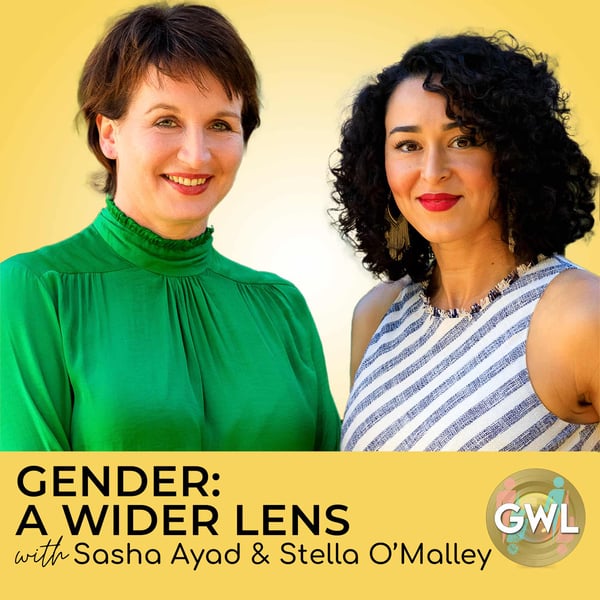44 - Multiple Meanings of Gender Dysphoria: A Conversation with Aaron Terrell
Gender: A Wider Lens
Sasha Ayad and Stella O'Malley
4.6 • 961 Ratings
🗓️ 8 October 2021
⏱️ 71 minutes
🧾️ Download transcript
Summary
Aaron Terrell transitioned female-to-male in 2011. He wasn’t involved in social media or the trans community until roughly 2017 when he noticed some unusual anomalies involving the new cohort of females identifying as trans men and undergoing medical transitioning. Then, earlier this year, Aaron read J. K. Rowling’s essay and everything changed.
Links:
Aaron’s blog:
Aaron on Twitter:
Gender Dysphoria Alliance:
Twitter.com/gd_alliance?lang=en
Dysphoria is not one thing:
4thwavenow.com/2017/12/07/gender-dysphoria-is-not-one-thing
Transparency Podcast:
Podcasts.apple.com/us/podcast/transparency/id1583333120
Unfiltered with Buck Angel (on UpperhandMARS):
Extended Notes:
- A little bit about Aaron and his journey.
- Why did Aaron decide to transition at 27?
- Aaron was introduced to a trans social circle when he was still in college, although it was nice to be with his tribe, certain topics made him uncomfortable.
- Did family members recognize Aaron’s struggles when he was going through puberty as a woman?
- Aaron shares his beliefs on religion, and what his religious upbringing was like.
- People are making their lives much more difficult by trying to opt out and be different with their gender.
- Why did Aaron start his blog and podcast?
- Aaron was largely helped by transitioning, but he understands the drawbacks and often writes about those drawbacks.
- Sasha reads an excerpt from his blog, and Aaron expands on his thoughts on the trans movement at the time.
- Aaron had a lot of internalized misogyny happening when he started to become a man.
- He was supposed to be a wife and a mother, and when he transitioned, what was next? It was natural for Aaron to be a breadwinner, and adopt an identity of what that “traditionally” looks like.
- When it comes to trans people using the male and female bathrooms, where does he stand on the issue? At first, he thought people who were offended by this were transphobes.
- Where does the ethical line get drawn on some of these controversial issues?
- With so many young children transitioning so early, what’s the fallout going to look like? Aaron believes there are going to be a lot of de-transitioners.
- What is the Gender Dysphoria Alliance all about?
This podcast is partially sponsored by ReIME, Rethink Identity Medicine Ethics:
Learn more about our show: Linktr.ee/WiderLensPod
This is a public episode. If you’d like to discuss this with other subscribers or get access to bonus episodes, visit www.widerlenspod.com/subscribe
Transcript
Click on a timestamp to play from that location
| 0:00.0 | You're listening to gender, a wider lens. |
| 0:04.0 | I'm Stella O'Malley, a psychotherapist in Ireland. |
| 0:06.5 | And I'm Sasha Ayad, an adolescent therapist in the United States. |
| 0:10.6 | Since 2016, my practice has been exclusively dedicated to gender questioning teens |
| 0:16.1 | and families impacted by gender dysphoria. I also work with gender questioning |
| 0:20.7 | teenagers and I facilitated support meetings for families and |
| 0:24.2 | individuals who have been impacted by gender issues. We're curious about the |
| 0:28.1 | concept of gender and how it's unfolding in the wider culture. Join us as we look at gender through a wider lens. |
| 0:37.6 | Aaron Terrell is a transgender man from the United States |
| 0:41.0 | who transitioned in 2011 at the age of 27. He's a founding member of |
| 0:46.1 | the Gender Dysforia Alliance and is a co-host of the Organization's Podcast, which is called Transparency. The organization and podcast both seek to |
| 0:55.8 | educate about gender dysphoria from the perspectives of those who |
| 0:59.3 | experience it, but without the sacred or fundamentalist tones that are often applied to the topic of transition. |
| 1:06.5 | In recent years, Aaron has become curious about the factors that contribute to female dysphoria |
| 1:11.7 | and the desire to transition and he's especially |
| 1:14.7 | interested in transition as a cultural phenomenon. Here's our conversation with |
| 1:19.5 | Aaron. Hi Stella, how are you today? Hi Sasha I'm I've been better but I'm I'm I'm still |
| 1:29.4 | still standing and I'm I'm very excited by our guest today should be very interesting conversation. |
| 1:37.0 | Hello, hello Sasha, hello Stella. |
| 1:39.0 | Thank you for having me. |
| 1:40.0 | Thank you, Erin for joining us. |
| 1:42.0 | Thank you for coming. Thank you for coming. |
... |
Please login to see the full transcript.
Disclaimer: The podcast and artwork embedded on this page are from Sasha Ayad and Stella O'Malley, and are the property of its owner and not affiliated with or endorsed by Tapesearch.
Generated transcripts are the property of Sasha Ayad and Stella O'Malley and are distributed freely under the Fair Use doctrine. Transcripts generated by Tapesearch are not guaranteed to be accurate.
Copyright © Tapesearch 2025.

